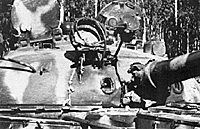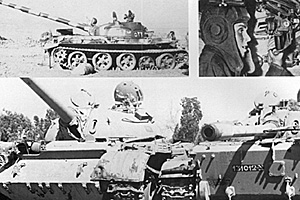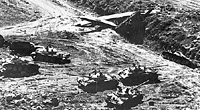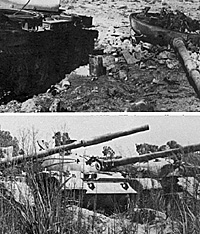As the T-62 is an improved version of the T-54/55 series, rather than a completely new design, all three tanks will be considered in general aspects as one type, since they share many of the same characteristics.
Standing 2.4 meters high, the T-54/55/62 has the lowest silhouette and the narrowest width (3.28 meters) of any of the combatant tanks. It presents the smallest possible frontal target area to hostile weapons systems. This small target area is enhanced by a ballistic shape that many armor experts consider the best ballistic design in existence today. Utilizing auxiliary external fuel tanks, the T-54/55/62 has the longest range (400 miles) of any of the combatant's tanks.
Both the 100mm rifled and 115mm smoothbore guns, firing a HEAT round, are capable of destroying any Israeli tank at 3,000 meters range.
Simple in construction, the T-54/55/62 is an easy vehicle to operate and a simple one to maintain. The light weight (36 tons) gives it an edge in mobility over the Israeli tanks. It would appear that the T-54/55/62 has excellent destructiveness.
 This tank park of destroyed and captured armored fighting vehicles (AFV) has both Arab T-54/55/62 tanks /left and center) as well as a Isradi M-48/60 vehicles (far right). In the foreground is an Egyptian CSP (PT-8} pontoon-laying tracked carrier. Two such vehicles linked together are capable of ferrying up to 52 tons tone MBT) and were used to move the first Arab tanks across the Suez Canal.
This tank park of destroyed and captured armored fighting vehicles (AFV) has both Arab T-54/55/62 tanks /left and center) as well as a Isradi M-48/60 vehicles (far right). In the foreground is an Egyptian CSP (PT-8} pontoon-laying tracked carrier. Two such vehicles linked together are capable of ferrying up to 52 tons tone MBT) and were used to move the first Arab tanks across the Suez Canal.
However, the above information is an example of how a simple comparison of data can misinform. To produce what appears to be an excellently designed tank, the Soviets have had to make compromises that penalize overall tank performance.
The apparent excellent survivability achieved by the low silhouette, narrow width, and the shape of the armor is neutralized by the inferior quality of that armor. Soviet industry appears to have serious problems with quality control in the steel manufacturing process. The quality of armor varies from tank to tank and is inferior to Western armor plate of equal thickness. It proved to be highly vulnerable to Israeli armor-piercing ammunition, and is weak on the sides and rear and especially in the deck area behind the turret.
 (Note the photographic evidence at right of the T-62 destroyed by a projectile that pierced both the 170mm thick mantles and the turret armor in back of it. )
(Note the photographic evidence at right of the T-62 destroyed by a projectile that pierced both the 170mm thick mantles and the turret armor in back of it. )
Although the T-54/55/62s low silhouette is the envy of Western designers, it has resulted in a very squat turret and restricts the depression of the main gun to a very slight angle (3 degrees). So, although the T-54/55/62 presents less of a target than a Western tank does when in the open, upon assuming a hull-down position the T-54/55/62 must expose itself more than a Western tank has to, in order to achieve a comparable field of fire.
It would appear that the Soviets design a tank by selecting the best ballistic shape and then cramming the necessary components into that shape. The small size of the T-54/55/62 has been achieved at the cost of poor internal stowage arrangements and cramped accessibility for the crew. The main fuel tank is located in the forward section on the right side of the crew compartment, with the driver seated to the left. Not only is the fuel tank vulnerable to destruction by penetration of the frontal armor, but the heat generated by the friction of a projectile glancing off the glacis can ignite the fuel without penetrating the armor. This liability to bum upon receiving a glancing hit caused Warsaw Pact nation observers during the Yom Kippur War to label the T-54/56/62 a "flaming coffin."
 A relatively undamaged Syrian T-62, with the track repaired by Israeli engineers for easy recovery.
A relatively undamaged Syrian T-62, with the track repaired by Israeli engineers for easy recovery.
Interior view of the T-S5 turret. Note the commander's TPK sight.
Fruits of victory: Lightly damaged T-55's recovered from the Sinai battlefield await Israeli reconditioning and modification. Note the Israeli serial numbers on the bow and rear.
Ammunition stowage is another problem. Rounds are stowed horizontally along the turret walls. This makes loading the main gun an awkward procedure and worse, because of the poor quality of the armor, the turret is particularly vulnerable to HEAT projectiles.
External fuel tanks add 100 miles to the tank's range, but they also provide an additional fire hazard as the fuel tanks are extremely vulnerable to small arms fire.
 These Syrian AFV's failed to cross the Israeli anti-tank ditch in the Golan heights. Scissors-bridges and tanidozers were used to cross the ditch, but at a tremendous price. Superior Jewish gunnery destroyed many Syrian tanks adwncing in the open towards the 1967 cease-fire line, before the Arabs could get within range to reply. At right, a T-55 is stranded in the ditch while another collapsed on the scissors bridge. Five T-62's (several with 12.7mm DShK turret-mounted machineguns) are grouped together for recovery by Jewish repair units. Note the snorkel tubes on the rear of their turrets. Some relatively lightly damaged BTR-152 wheeled armored personnel carriers (APC) were also abandoned here.
These Syrian AFV's failed to cross the Israeli anti-tank ditch in the Golan heights. Scissors-bridges and tanidozers were used to cross the ditch, but at a tremendous price. Superior Jewish gunnery destroyed many Syrian tanks adwncing in the open towards the 1967 cease-fire line, before the Arabs could get within range to reply. At right, a T-55 is stranded in the ditch while another collapsed on the scissors bridge. Five T-62's (several with 12.7mm DShK turret-mounted machineguns) are grouped together for recovery by Jewish repair units. Note the snorkel tubes on the rear of their turrets. Some relatively lightly damaged BTR-152 wheeled armored personnel carriers (APC) were also abandoned here.
In the desert environment, the engine tends to overheat, necessitating running the engine with the engine compartment louvres open a good deal of the time. The open louvres increase the engine's vulnerability to small arms fire.
One of the methods of achieving the tank's light overall weight is the use of an engine constructed of aluminum-magnesium alloy. While the engine is very light, it also tends to burn like a magnesium flare when hit. Thus the combination of weak armor and a variety of fire hazards give the T-54/55/62 a poor survivability factor.
In terms of firepower, the 100mm/115mm guns are excellent, but again there are neutralizing factors. The TPK-1 optical sight does not hold a bore sight for very long and the stadiametric ranging equipment requires a high degree of training and experience to be effective. Thus the maximum effective range of the main gun is 1,000 meters, not because of any limitation of the gun, but because of the inadequacies of the sighting system.
Lack of a turret basket and the poor layout for ammunition stowage makes loading the main gun a clumsy operation for the loader, resulting in a practical sustained rate of fire of 3 rounds per minute. The T-54/55/62 has an additional loading problem in that the gun is mounted too close to the turret roof and must have the breech lowered before the loader can place a new round into the top-loading breechblock. This continual raising and lowering of the gun tube disrupts the lay of the gun, so each round must be respotted on firing. Rapid accurate fire is almost impossible.
 Top: In tank battles, the first ACCURATE shot usually wins.
Top: In tank battles, the first ACCURATE shot usually wins.
Note the mounting bracket for the infra-red searchlight on the center T-62. This equipment enabled the Arabs to press their attacks at night, while the Jews were limited to flares and occasional searchlights to aid them in their defense.
Spent shell casings have to be carried inside the crew compartment of the T-54/55, cluttering a cramped area even more, but the T-62 has eliminated this problem with an automatic shell casing ejection system which expels the spent casings through a hatch in the rear of the turret.
Destructiveness can be considered good at ranges up to 1,000 meters, but decreasing as the range to the target increases. In terms of accurate rate of fire, the T-54/55/62's destructive capability is fair.
Although it is a simple tank to operate and maintain, the T-54/55/62 broke down more often than Israeli tanks did. A partial explanation is the continuing lack of Arab maintenance skill, but there is also a problem with the reliability of components and some difficulty with engine lubrication that results in a reduced engine life.
Because of the cramped interior layout, and smaller amount of space, the crew compartment is hotter than in Western tanks and habitability is poor. Although the Russians have compensated for this by restricting the size of their tank crewmen to 5 feet 4 inches or smaller, the Arabs lack a comparable manpower pool to draw upon for tank crews, and the individual of requisite height may not possess the requisite technical and physical skills to be a tank crewman. Additionally, the undersize loader has more of a problem handling the 100mm/115mm rounds than a loader of average height, unless the Russians and the Arabs have developed a method for breeding short, extremely stocky crewmen.
So, although the external fuel tanks enable the tank to go farther than a Western tank, crew fatigue will hamper the effectiveness of the T-54/55/62 once it reaches its objective.
There are not enough vision blocks on the T-54/55/62. If the tank commander exposes himself to obtain good all-around vision this is not a crucial problem. But as the Arabs fight their tanks "buttoned-up" there are many blind spots in the tank's vision, making it easy prey for aggressive infantry anti-tank teams, if close infantry support is lacking.
Running the tank at or near top speed for any length of time creates another problem, for a harmonic vibration develops in that part of the tread which is not in contact with the ground, quickly snapping the tread. This problem has been solved on the new Soviet T-64 tank with the installation of return rollers, but the mobility of the T-54/55/62 is still hindered by this tread-shedding tendency. Therefore, the availability factor can only be rated as fair.
More Arab-Israeli Armor 1973
-
Arab-Israeli Armor 1973: Introduction
Arab-Israeli Armor 1973: T-54/55/62
Arab-Israeli Armor 1973: M-48/60
Arab-Israeli Armor 1973: Centurion Mk 5
Arab-Israeli Armor 1973: TO&E
Arab-Israeli Armor 1973: Jewish Tank Markings
Arab-Israeli Armor 1973: Tanker Crew
Arab-Israeli Armor 1973: Comparative Data (Chart)
Arab-Israeli Armor 1973: Comparative Ammunition
Arab-Israeli Armor 1973: Observations and Conclusions
Arab-Israeli Armor 1973: Paper Tanks
Arab-Israeli Armor 1973: Bibliography
Arab-Israeli Armor 1973: Glossary of Terminology
Arab-Israeli Armor 1973: 1/64 Scale Illustrations (extremely slow: 439K)
Back to Conflict Special Study 1 Table of Contents
Back to Conflict List of Issues
Back to MagWeb Master Magazine List
© Copyright 1975 by Dana Lombardy
This article appears in MagWeb (Magazine Web) on the Internet World Wide Web.
Other military history articles and gaming articles are available at http://www.magweb.com